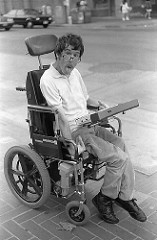Scientists from the École Polytechnique Fédérale de Lausanne have made it possible for paralyzed rats to walk again using electrical and chemical stimulation. In humans, however, this would require long-term implants that would not cause tissue damage. The e-Dura implant, developed by research teams led by professors Stéphanie Lacour and Grégoire Courtine, is one such implant.
Previous surface implants were unable to be installed long-term due to the nerve tissues rubbing against the devices. The repeated contact between the implant and the tissues causes inflammation, eventually leading to the rejection of the device.
The e-Dura implant imitates living tissue through its flexibility and stretchiness. The elasticity of the device greatly reduces any inflammation that might be caused by friction between the implant and the surrounding nerve tissue. The implant is placed on the surface of the brain or spinal cord, beneath the dura mater, a fibrous membrane. In rats, the device did not cause any damage and was not rejected, even after two months. After a couple weeks of training, the previously paralyzed rats were able to walk by themselves.
Image Source: VintageMedStock
Our e-Dura implant can remain for a long period of time on the spinal cord or the cortex, precisely because it has the same mechanical properties as the dura mater itself. This opens up new therapeutic possibilities for patients suffering from neurological trauma or disorders, particularly individuals who have become paralyzed following spinal cord injury.
-Stéphanie Lacour
As of now, the e-Dura implant has only been tested in paralyzed rats. However, this device has major implications for humans in areas like epilepsy, Parkinson’s disease, and pain management. The researchers have plans to start clinical trials in humans and prepare the e-Dura implant for commercialization.
Feature Image Source: Paralysis by Neil Hester










